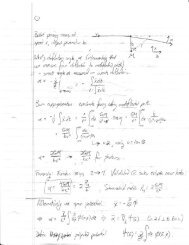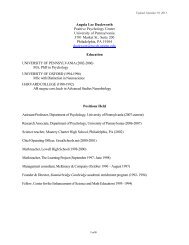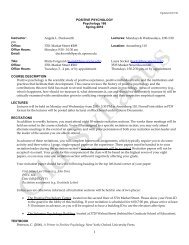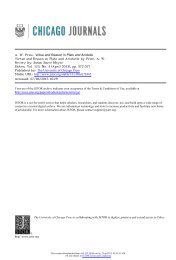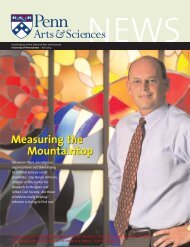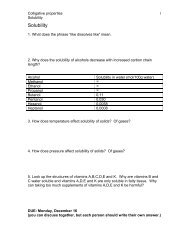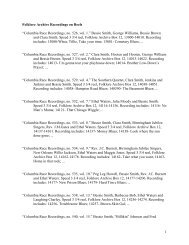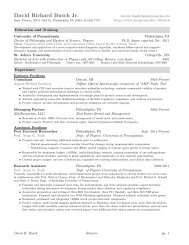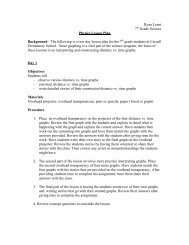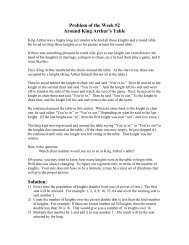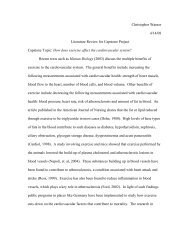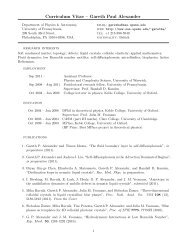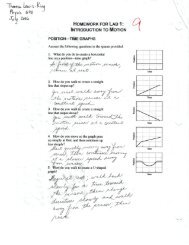Full Lesson Plan - School of Arts & Sciences
Full Lesson Plan - School of Arts & Sciences
Full Lesson Plan - School of Arts & Sciences
You also want an ePaper? Increase the reach of your titles
YUMPU automatically turns print PDFs into web optimized ePapers that Google loves.
Story <strong>of</strong> Charles’ Law<br />
To begin the story <strong>of</strong> Charles law, we should first look at the early<br />
attempts <strong>of</strong> discovery by Robert Boyle and Guilliame Amonton. In 1622<br />
Boyle had published his work on the inverse relationship between a gas’<br />
pressure and volume, a law that would later bear his name. He was aware <strong>of</strong><br />
the increase in volume <strong>of</strong> a gas when heated, but a temperature scale did not<br />
exist then. In the early 1700’s Amonton did many experiments involving a<br />
gas’ volume and its temperature, but like Boyle a temperature scale did not<br />
exist. (Thall, n.d.)<br />
So we can now look at the gentleman who the law is named after.<br />
Jacques Charles was a Frenchman who early on in his life had very little<br />
science education. While working in a Paris Government Office he had a<br />
chance encounter with the American Ambassador to France, Benjamin<br />
Franklin. After hearing <strong>of</strong> Franklin’s experiments and scientific ideas,<br />
Charles decided to teach himself some science. This self teaching eventually<br />
led to public lectures and then to the Academy <strong>of</strong> Science, where he began to<br />
develop a respectable reputation. (Ellyard, 2005)<br />
It was here in 1783 that the Montg<strong>of</strong>ier brothers asked Jacques<br />
to look at their new mode <strong>of</strong> travel, the hot air balloon. After careful<br />
scrutiny, Charles stated that he believed that for the safest and surest form <strong>of</strong><br />
travel the balloon should be filled with” a very light flammable air<br />
(hydrogen) rather than heating the air over fire.”(Ellyard, 2005) In August <strong>of</strong><br />
that year he but his theories to the test. He got his first balloon and filled it<br />
with hydrogen by pouring sulfuric acid over scrap iron (later zinc). He went<br />
to a field, where the Eiffel tower now stands, and sent his balloon up 10 km.<br />
After more trials he soon started to notice that the balloon’s volume would<br />
expand as the balloon went up into lower air pressure. This was not anything<br />
new; it was simply proving Boyle’s Law from 1659. More importantly he<br />
saw a connection between heating the gas and the gas’ volume. (Ellyard,<br />
2005)<br />
In 1787 Charles decided to investigate this relationship further. He<br />
went out and got a J-shaped glass tube that Robert Boyle had used in his<br />
study <strong>of</strong> gases. He placed the tube in a water bath so he could manipulate the<br />
temperature <strong>of</strong> the gas. He held the pressure <strong>of</strong> the trapped gas bubble steady<br />
by “keeping a constant difference between mercury levels in the two arms <strong>of</strong><br />
the tube,” (Ellyard, 2005) This would make pressure a non factor in his<br />
experiments. He then went about changes the temperature <strong>of</strong> the water bath<br />
and observing the effect on the trapped gas bubble. His results showed that<br />
5



